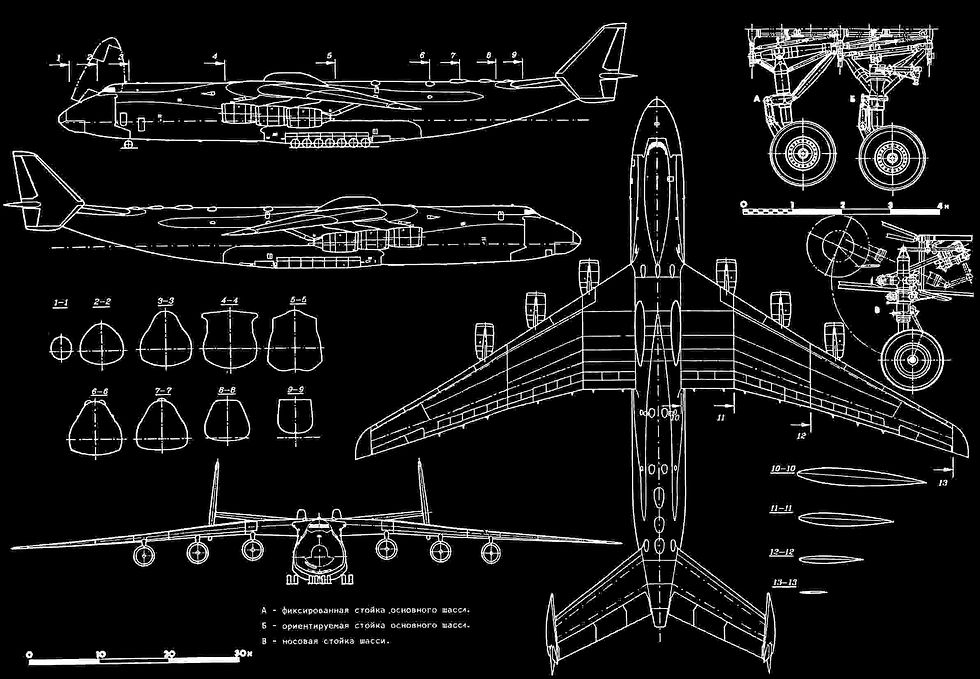Antonov AN-225 Mriya – Rebirth of a Giant
- Garth Calitz
- Sep 25, 2019
- 5 min read
The Antonov AN-225 Mriya, codenamed "Cossack" by NATO, is a super heavy strategic airlift cargo aircraft. Designed and built by then Soviet Union, Antonov State Company in the 1980's, she is powered by six turbofan engines. The AN-225 is the world's longest and heaviest airplane ever to take to the air. This incredible piece of engineering has a maximum take-off weight of around 710 tons and has the largest wingspan of any aircraft currently in active service, the only aircraft to have a larger wingspan is the now defunct Stratoluancher.

The Antonov AN-225 was first developed to transport the Buran spaceplane and Energia rocket boosters for the Soviet space program. She was designed and built to replace the aging Myasishchev VM-T. The original concept for the AN-225 was, in effect, identical to the U.S.'s Shuttle Carrier Aircraft. Her first flight was on the 21st December 1988 where it completed a 74-minute flight out of Kiev in the Ukraine.


Myasishchev VM-T
This incredible aircraft had a very short working life as Buran space shuttle was only deployed in one orbital launch on 15 November 1988 from Baikonur Cosmodrome launch pad 110/37. Buran was lifted into space, on an un-crewed mission, by the specially designed Energia rocket. The automated launch sequence performed as specified, and the Energia rocket lifted the vehicle into a temporary orbit before the orbiter separated as programmed. After boosting itself to a higher orbit and completing two orbits around the Earth, the ODU engines fired automatically to begin the descent into the atmosphere, return to the launch site, and horizontal landing on a runway. After conducting its intended purposes for the Buran space program, not to mention some airshows, the fall of the Soviet Union in the early 90's saw the AN-225 mothballed until further notice. During her time in service, the Antonov AN-225 completed 14 flights with a total flight time of 28 hours and 27 minutes

In around the year 2000 plans were put into motion to modernise the airframe for future use. These works were intended to improve the aircraft for carrying commercial cargo. A task she has performed ever since for Antonov Airlines.

Antonov-225's cargo hold is truly breath-taking. It has a very spacious cargo hold with a total length of 43.32 meters, a width of 6.4 meters and height of 4.4 meters, large enough to swallow an entire B737 fuselage.

Her cargo hold has a total volume or around 1,300 cubic meters. This capacity enables the airplane to transport sixteen standard aeronautical containers or 50 cars or single pieces of cargo up to 200 tonnes in weight. Her cargo hold can be pressurized, as you'd expect. This enables the plane to extend its transport capabilities. The AN-225's carrying capacity isn't limited to her cargo hold, however. She is able to transport many unique cargoes outside her fuselage.

Based on Antonov's earlier An-124, the An-225 has fuselage barrel extensions added fore and aft of the wings. The wings also received root extensions to increase span, wings are anhedral. The flight control surfaces are controlled via fly-by-wire and triple-redundant hydraulics. Two more Progress D-18T turbofan engines were added to the new wing roots, bringing the total to six.

Progress D-18T turbofan engine
An increased-capacity landing gear system with 32 wheels was designed, some of which are steerable, enabling the aircraft to turn within a 60-metre-wide (200 ft) runway. Like it’s An-124 predecessor, the An-225 has nose gear designed to "kneel" so cargo can be more easily loaded and unloaded. Unlike the An-124, which has a rear cargo door and ramp, the An-225 design left these off to save weight, and the empennage design was changed from a single vertical stabilizer to a twin tail with an oversized, swept-back horizontal stabilizer. The twin tail was essential to enable the plane to carry large, heavy external loads that would disturb the airflow around a conventional tail. Unlike the An-124, the An-225 was not intended for tactical airlifting and is not designed for short-field operation.

AN 124
As amazing as this aircraft is only one was ever built by the Soviet Union a second airframe was partially completed but after the fall of the Soviet Union work was halted. The AN-225's sister aircraft has not been forgotten, however. Work was briefly restarted in 2009 with later agreements in 2016. This was to complete the work for the Aerospace Industry Corporation of China as a prelude to AICC commencing series production. This agreement will mean that the second previously aborted airframe will be completed by the end of the decade. The entire process includes the transfer of the technology to China for licensed production to a modernized standard.

AICC plan to open up new frontiers in commercial and military transportation with a fleet of AN-225's to deliver heavy payloads on a mass scale for construction and delivery of consumer goods. In 1989 it started operating from London Luton airport. They also plan to use the AN-225 fleet for humanitarian aid during disaster events. China also envisages their use for transporting large amounts of military hardware from helicopters to tanks, even ballistic missiles anywhere in the world. They also plan to use the fleet to help launch spacecraft or provide a "mothership" for drone operations.

The AN-225 has broken hundreds of world records these include The Largest Aircraft by Weight, Largest Aircraft by Wingspan and Heaviest item airlifted. The AN225 also managed to carry the world's heaviest recorded load at 253 tonnes, the heaviest single piece of cargo at 186.7 tonnes and the longest cargo ever transported by air at 42.1 meters.

The aircraft continues to attract a high degree of public interest, so much that it has managed to attain a global following due to its size and its uniqueness. People frequently visit airports to see its scheduled arrivals and departures, such as in Perth, Australia in May 2016 where a crowd of more than 50,000 people gathered at Perth Airport.

The AN225’s first flight in commercial service departed from Stuttgart, Germany on 3 January 2002, and flew to Thumrait, Oman with 216,000 prepared meals for American military personnel based in the region. This vast number of ready meals was transported on 375 pallets and weighed 187.5 tons.
The Mriya has since become the workhorse of the Antonov Airlines fleet, transporting objects once thought impossible to move by air, such as 150-tonne generators. It has become an asset to international relief organizations for its ability to quickly transport huge quantities of emergency supplies during disaster relief operations.
The An-225 has been contracted by the Canadian and U.S. governments to transport military supplies to the Middle East in support of coalition forces. An example of the cost of shipping cargo by An-225 was over $200000 for flying a chimney duct from Billund, Denmark to Kazakhstan in 2004.
On 11 August 2009, the heaviest single cargo item ever sent via air freight was loaded onto the An-225. At 16.23 m long and 4.27 m wide, its consignment, a generator for a gas power plant in Armenia along with its loading frame, weighed in at a record 189 tons.

On 11 June 2010, the An-225 carried the world's longest piece of air cargo, two 42.1 m (138 ft) test wind turbine blades from Tianjin, China to Skrydstrup, Denmark.




























Kommentit